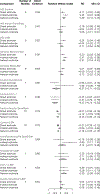Interventions for Reversing Prediabetes: A Systematic Review and Meta-Analysis
- PMID: 35151523
- PMCID: PMC10420389
- DOI: 10.1016/j.amepre.2021.10.020
Interventions for Reversing Prediabetes: A Systematic Review and Meta-Analysis
Abstract
Introduction: Several interventions have been found to be effective for reversing prediabetes in adults. This systematic review and meta-analysis aims to compare the effectiveness of such interventions.
Methods: MEDLINE, Embase, and Cochrane Library databases were searched for articles published between January 1, 2000 and June 27, 2018. RCTs in adults with prediabetes, testing nonsurgical interventions lasting for ≥3 months, and reporting the number of participants achieving normal glucose levels at intervention end were eligible. The pooled risk difference and number needed to treat for achieving normoglycemia were estimated using a random-effects, arm-based network meta-analysis. The strength of the evidence was assessed using Grading of Recommendations Assessment, Development, and Evaluation. Data were obtained in 2018 and analyzed in 2019 and 2021.
Results: Of 54 studies included in the systematic review, 47 were meta-analyzed (n=26,460, mean age=53 years, 46% male, 31% White). Studies included 27 arms testing lifestyle modification interventions, 25 testing medications, 5 testing dietary supplements, and 10 testing Chinese medicine. There were 35 control/placebo arms. At a median follow-up of 1.6 years, more participants in the lifestyle modification groups achieved normoglycemia than those in the control (risk difference=0.18, number needed to treat=6). The strength of the evidence was strong for lifestyle modification. Over a median follow-up of 2.7 years, more participants receiving glucagon-like peptide-1 receptor agonists (risk difference=0.47, number needed to treat=2), α-glucosidase inhibitors (risk difference=0.29, number needed to treat=4), and insulin sensitizers (risk difference=0.23, number needed to treat=4) achieved normoglycemia than control. The strength of evidence was moderate for these medications.
Discussion: Although several pharmacological approaches can reverse prediabetes, lifestyle modification provides the strongest evidence of effectiveness and should remain the recommended approach to address this condition.
Copyright © 2021 American Journal of Preventive Medicine. Published by Elsevier Inc. All rights reserved.
Conflict of interest statement
The authors have no conflicts of interest to declare during the course of this work. No financial disclosures were reported by the authors of this paper.
Figures





Comment in
-
We Need Lifestyle Modification Trials for the Reversal of Impaired Fasting Glucose.Am J Prev Med. 2022 Oct;63(4):664-665. doi: 10.1016/j.amepre.2022.04.013. Am J Prev Med. 2022. PMID: 36137669 No abstract available.
References
-
- International Diabetes Federation. IDF Diabetes Atlas, 9th Edition. https://www.diabetesatlas.org/en/. Published 2019. Accessed on March 19, 2020.
REFERENCES FOR THE 54 STUDIES IDENTIFIED IN THE SYSTEMATIC REVIEW
-
- Perreault L, Pan Q, Mather KJ, Watson KE, Hamman RF, Kahn SE. Effect of regression from prediabetes to normal glucose regulation on long-term reduction in diabetes risk: results from the Diabetes Prevention Program Outcomes Study. Lancet. 2012;379(9833):2243–2251. 10.1016/s0140-6736(12)60525-x. - DOI - PMC - PubMed
-
- Snehalatha C, Mary S, Selvam S, et al. Changes in insulin secretion and insulin sensitivity in relation to the glycemic outcomes in subjects with impaired glucose tolerance in the Indian Diabetes Prevention Programme-1 (IDPP-1). Diabetes Care. 2009;32(10):1796–1801. 10.2337/dc09-0676. - DOI - PMC - PubMed
Publication types
MeSH terms
Grants and funding
LinkOut - more resources
Full Text Sources
Medical

